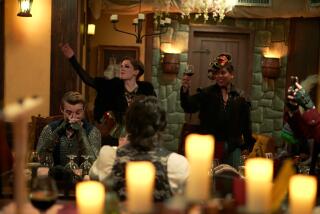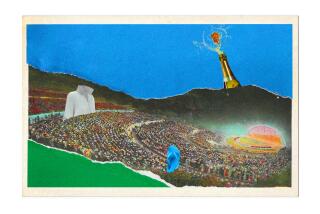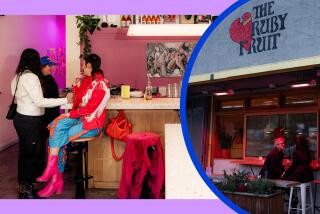Sexual Ornament or Invitation to Harassment at Hooters Bar? : Lawsuits: A lawyer for several former waitresses calls it a ‘corporate culture of misogyny.’ But the chain’s attorneys and officials say they are only marketing ‘sex appeal.’
BLOOMINGTON, Minn. — Former waitress Whitney Miller remembers the customer who refused to pay for his food--unless she took off her shirt.
That, he thought, “was what Hooters was for.”
Was he mistaken? A growing number of critics of Hooters, a chain of bar-restaurants, would say he was right on the money.
They say Hooters’ success--107 franchises in 28 states and annual sales in excess of $150 million--is built on a corporate image that uses women employees as sexual ornaments and, according to recent lawsuits, encourages unwelcome sexual advances by customers and managers.
One lawyer who has filed sexual harassment lawsuits on behalf of former Hooters waitresses calls it a “corporate culture of misogyny.”
Protests have been launched in Illinois, Maryland, Michigan, Ohio and Virginia. The National Organization for Women has raised objections, and Working Woman magazine inducted Hooters into its 1992 Hall of Shame.
Like many other bars, Hooters features waitresses--”Hooters Girls”--in scanty costumes, taking orders for beer and chicken wings.
But Hooters attorneys and company officials deny that they’re marketing anything more than innocent “sex appeal.” The lawsuits are “outrageous,” they say.
And the name? It’s not a double-entendre reference to women’s breasts, Hooters’ management says. It’s about owls.
“For us, Hooters is just the name of the restaurant,” said Mike McNeil, vice president of marketing for Hooters of America Inc., in Atlanta. “If that was our desire, to blatantly name it after a portion of the female anatomy, there are much more blatant slang terms that we could utilize.”
No question. When the original Hooters opened in Clearwater, Fla., in 1983, it inspired several competitors: Knockers, Melons, and Mugs ‘n’ Jugs.
Seven harassment lawsuits have been filed by former waitresses at the Hooters bar in the Mall of America, the giant shopping and entertainment complex in the Minneapolis suburb of Bloomington. Another sexual harassment lawsuit was filed in early July in Ft. Lauderdale, Fla., by a former Hooters waitress.
At the heart of the lawsuits is the argument that Hooters’ “concept”--waitresses in scanty costumes, nod-and-a-wink references to women’s anatomy, cheesecake calendars and swimsuit photo magazines featuring “Hooters Girls”--invites sexual harassment of women employees.
That harassment, the Minnesota lawsuits say, included Hooters’ managers and other employees grabbing and propositioning women employees and commenting about their breasts. One of plaintiffs, Dawn Felepe, said she was propositioned by Hooters managers at least 50 times in the nine months she worked there.
Customers also felt free to make sexual comments, the lawsuits say. Some waitresses said they were asked if they wore underwear. Others were asked their bra size. Others were simply asked for sex.
Managers told them to tolerate it, the women say.
Miller, one of the plaintiffs, said managers told her she shouldn’t work as a “Hooters Girl” anymore because her breasts became smaller after she stopped breast-feeding her son.
As a 25-year-old single mother, Miller worked six months at Hooters to support her son. Her attorney, Lori Peterson of Minneapolis, said Hooters offered her the job before the restaurant opened and wasn’t candid about the requirements.
“I now realize that no amount of money is worth being a sexual target because I’m female,” Miller said, when the lawsuits were filed.
Lisa Gray, Hooters’ attorney in Minneapolis, said the lawsuits contain “outrageous and inflammatory allegations that are clearly written for press consumption.” McNeil denies that the Hooters concept degrades women.
“Hooters Girls in our concept are put on pedestals,” he said. “We treat them like a celebrity. We even put them on Hooters Girl trading cards.”
Still, the first thing that greets visitors to the restaurants is the Hooters logo, an owl whose enormous, round orange eyes form the O’s in “hooters” and look like line-drawing representations of breasts.
This is how the Hooters menu explains the name: “The dilemma . . . what to name the place. Simple--what else brings a gleam to men’s eyes everywhere besides beer and chicken wings and an occasional winning football season. Hence, the name Hooters.”
Some Hooters restaurants have also used the slogan “More than a mouthful” on T-shirts worn by waitresses. McNeil said it’s not the company’s official slogan, and some restaurants have stopped using it.
At the Mall of America Hooters, some waitresses--there are no waiters--wear form-fitting hot-orange jogging shorts. Some wear T-shirts cropped at the midriff; others pull shirts taut. A few wear looser T-shirts tucked into roomier shorts. The women are required to wear shorts, even in winter, while male employees--managers and cooks--are allowed to wear long pants.
One “Hooters Girl” at the Mall of America said the uniforms are comfortable, the money good, the co-workers and customers friendly. “I’ve never been harassed,” said Amy Calvin, 20, a psychology student.
Her customers have no illusions, and make no apologies. “I’m a guy. What can I say,” Dave Johnson, 29, of Newington, Conn., said, shrugging.
And company managers say they’re not about to start hiring Hooters Boys.
Said McNeil: “When you get a concept that works as well as this one does . . . you don’t want to change where you put the salt and pepper shakers, let alone something as essential to the concept as the Hooters Girls.”
More to Read
Inside the business of entertainment
The Wide Shot brings you news, analysis and insights on everything from streaming wars to production — and what it all means for the future.
You may occasionally receive promotional content from the Los Angeles Times.










